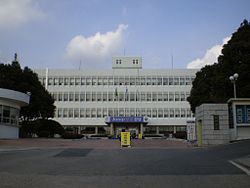Changnyeong Town
|
Changnyeong-eup 창녕읍 |
|
|---|---|
| Town | |
| Korean transcription(s) | |
| • Hangul | |
| • Hanja | |
| • Revised Romanization | Changnyeong-eub |

County Hall
|
|
 Location in South Korea |
|
| Country |
|
| Region | Gyeongnam |
| Established | 555 |
| Administrative divisions | 17 Legal village 법정리, 31 administrative villages 행정리, 161 neighborhoods 반 |
| Government | |
| • Mayor | Chung Shik Kim 김충식 |
| Area | |
| • Total | 61.42 km2 (23.71 sq mi) |
| Elevation | 2 m (7 ft) |
| Population (Apr 2013) | |
| • Total | 16,723 |
| • Dialect | Gyeongsang |
| Time zone | UTC+09:00 |
| Website | Changnyeong City Office |
Changnyeong-eup (창녕읍, 昌寧邑) is a town (eup) in the administrative county of Changnyeong, South Gyeongsang Province, in South Korea.
The town is Changnyeong county's administrative, business, and traffic center where most of the farm produce is bought and sold. It is nearly in the center of the county and is accessible via the Seoul-Busan expressway and national roads 5 and 24.
Changnyeong Town contains many national treasures and is situated in the middle of Changnyeong county's three major tourist attractions, Upo wetland, Bugok natural hotsprings, and Hwawang mountain.
Changnyeong (from Korean Changnyeong, meaning 'prosperous peace';from chang (Korean),(Hanja) , meaning 'prosperity', and nyeong (Korean),(Hanja) , meaning 'peace')
Changnyeong is located in the central eastern part of Changnyeong county, with Miryang (밀양시) and Muan township (무안면) to the east, Goam township (고암면) to the north, Daeji township (대지면) and Yueo township (유어면) to the west, and Kyeseong township (계성면) to the south. The eastern part of the town is mountainous beginning with Mount Hwawang. The western part of the town has a hot and humid climate and is made up of rolling plains which are used for cultivating rice, onions, garlic, and peppers.
Timeline of Changnyeong history:
Hwawang Mountain, Changnyeong Downtown Market, Changnyeong History Museum, Seokbinggo
Coordinates: 35°32′40″N 128°29′32″E / 35.544414°N 128.492181°E
...
Wikipedia
